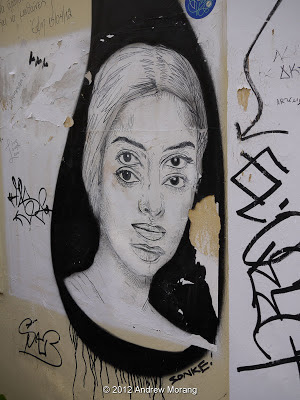The Acropolis hill has been occupied since Neolithic times. For millennia, people lived around the base of the hill because it was blessed with natural springs. But when visiting Athens today, other than the Acropolis and various other classical remains such as the Agora, most of what we see is a modern city. The first post-Turkish-era king of the modern state, King Otto, brought in his Bavarian architects to design an elegant European capital city with a palace (now the Parliament), parks, and broad boulevards. Greece and Athens suffered terribly during World War II and in the brutal Civil War that followed. But much of what we see today was the result of frantic uncontrolled urban expansion that followed the end of the Civil War in 1949. Beautiful old mansions and municipal buildings were torn down and replaced with concrete boxes. Now they look like mass-produced, tired 1960s concrete boxes.

First some geography. The Acropolis is the limestone hill in the middle of the view. This is a photograph taken from Lycabettus Hill facing west at sunset. The port city of Piraeus is in the upper right, and ferry boats and container ships are in the roadstead off the port. The big temple on the Acropolis is the Parthenon. Look at the base of the limestone bluff below the Parthenon, and you can see a cluster of small houses. This is known as the Pláka district (Greek: Πλάκα). The uppermost houses are the Ano Plaka or upper Plaka. This area has been inhabited for centuries, and this is all that remains of medieval Athens.
Now let's reverse positions. This is the view east from the base of the Acropolis towards the Lycabettus hill. The post-World War II city fills the entire valley now.
This is the view from the Acropolis in 1900. The royal palace (now parliament building) is in the distance, and the city spreads out in the foreground. I scanned this from the left side of a stereo card. The only printed information stated, "Webster & Albee, Rochester, NY."
Walking in the warren of lanes in Ano Pláka, you almost think you are in a village (if you ignore the din of the traffic in the distance). On a sunny day, the area has an island look.
Most of the houses have been restored since the 1960s, when this was a hippy haven and pretty grungy.
Cats love it up here, especially on a warm sunny day.
There is a lot more graffiti now, worse then I ever remember it. This is one consequence of the Greek economic crisis.
There is also widespread disgust with the priesthood, but, to its credit, the church runs many soup kitchens and helps the hungry and poor. (The priest above is carrying a bag of Euros).
There are still some dilapidated lots in Pláka, just waiting for a rich American to bring funds and start restoring. Ever hear the term, "money pit?"
As you descend into the Kato (lower) Pláka, you enter the popular tourist area, rife with restaurants and souvenir shops.
This is the Temple of the Winds, in which a water clock once measured the time. The Acropolis is in the distance.
Finally, the Athens flea market is worth a visit. In the 1950s, I remember this being filled with vendors of car parts, mufflers, old clothes, toys, used tools, and junk in general. It has been gentrified, and many of the stores sell pseudo-designer clothes, souvenirs, and miscellaneous modern junk. I did find a music store with a good collection of Maria Callas CDs. We will explore the flea market in more detail later.
The equally colorful
Central Market is only a 10-minute walk away towards Omonia Square.
Best wishes for a prosperous 2013 to all readers!























































